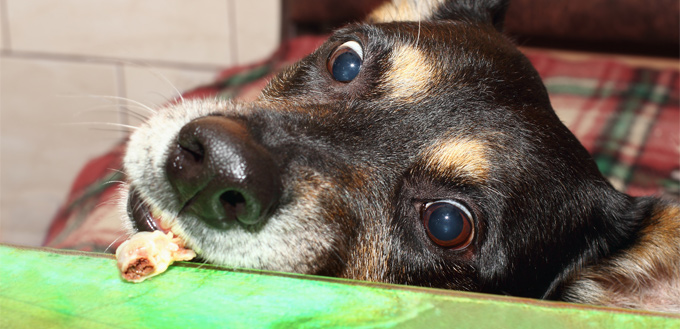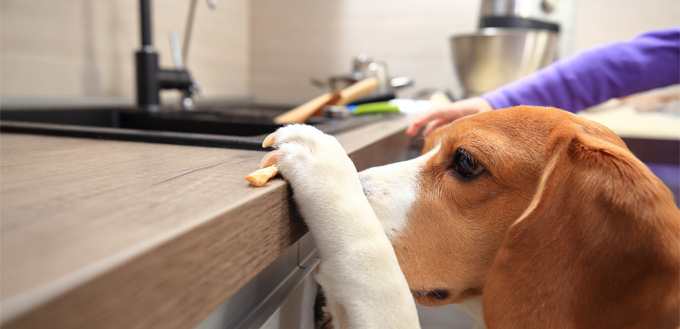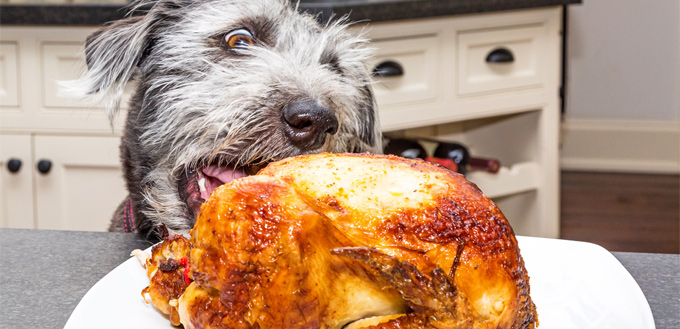There are all sorts of behaviours in dogs that drive you mad. Maybe they shred your sofas or they bark at night or perhaps they enthusiastically lick your guests’ faces? There is one habit in particular that many dogs exhibit, but no pet parent enjoys, and that is ‘counter surfing’. So, we’ve put it upon ourselves to teach you how to stop counter surfing in dogs.
What is Counter Surfing?
Counter surfing is a phrase coined to describe dogs stealing food from kitchen counters. I don’t know about you, but many of my dogs have thought of my kitchen counter as their own personal buffet. One or two have them have even thought of it as a game that we are playing. One where they win if they manage to steal something from the counter, but I win if I catch them. They look at me with this mischievous, ‘I’m so innocent’ look, and then as soon as my back is turned, something disappears.
There are all sorts of reasons why over the years I have wanted to discourage this kind of behaviour:
- Not all human food is good for dogs. I live in fear that they might sniff out some chocolate, bacon, cheese, onions or any of the many other foods that could make them ill. I find being strict and careful on issues such as these is infinitely better than the alternative – an urgent trip to the vet.
- If your dog does this often, it can lead to obesity, particularly if they are sneaky about it. Imagine if your dog is stealing some of your ingredients every time you cook for your entire family, and then is also eating their own meals. That is way too much food for their size, and I worry that this is a key contributing factor in unhealthy dogs.
- The kitchen is full of dangerous objects, such as knives and hot stoves. I want my dogs to know that jumping onto countertops, getting excitable, and generally messing around in the kitchen is an absolute no-no. Many owners simply ban their dog from the kitchen using dog gates or behaviour training. But others, like myself, need the kitchen for access to the garden or don’t have homes big enough to start cutting off rooms. In these cases, you need to train your dog to behave safely in the kitchen.
- It ruins my cooking! Obviously, my dogs’ health and safety is my paramount concern. But the truth of the matter is that it is also very annoying for my ingredients to go missing. I’ve had some almost-ruined parties, and even one Christmas lunch when something crucial has been nicked or contaminated by a pet.

Types of Training
If you want to stop counter surfing dogs, you are going to have to put the work in and train it out of them. If you are willing and patient, this shouldn’t be too difficult, but you need to prepare carefully and consider all your options. There are three main forms of training that you could pursue
- Negative Reinforcement: This is the idea that behaviour can be controlled by the unpleasant consequences that follow it. In this case, if your dog knows that they get punished for counter surfing then, in theory, they will stop.
- Removal of Reinforcement: If you want a behaviour to stop, then take away any temptation. Over time, the behaviour will disappear as it is not being reinforced with positive stimuli; in this case, the food.
- Positive Reinforcement and Redirection: Encourage new behaviours with rewards. Ideally, these new behaviours would replace or even contradict, the bad behaviour you are trying to get rid of.
Take a look at our article on Dog Treats.
Negative Reinforcement
The most direct and simple way to prevent dogs from counter surfing is to punish them when they do it. Some people train dogs using water sprays, others stick to loudly shouting things like ‘No’, ‘Stop’ and ‘Bad Boy’ clearly and authoritatively, and a few choose to believe in a dangerous, and unproven, technique called ‘alpha rolling’ in which you are essentially pinning your dog to the floor as a punishment. The idea is that the dog will come to associate the behaviour with the negative consequence and will stop the behaviour. It is the same principle that underlies some human behaviours such as learning to clear up after yourself or learning not to procrastinate.
The Problem with Negative Reinforcement
The problem with ‘alpha rolling’ and other physical techniques is obvious – it can be dangerous for your dog. But, did you know that negative reinforcement, on the whole, is often criticised by experts? It is often thought that negative reinforcement has two key problems.
- Outcomes can be difficult to predict. Your dog might not understand what they are being punished for, and this means their behaviour might not change in the ways that you intended.
- Punishment is likely to increase anxiety in pets. Partly because they might not understand what is happening, and partly due to fear, your pet is likely to develop feelings of dread and cautiousness if they are regularly punished.
In the case of counter surfing, you might be spraying your dog when they jump up onto the counter, for example, but they might learn to become frightened of the kitchen as a whole. If you keep their food and water in there, this might have an adverse impact on their health. Similarly, you might be punishing your dog whenever you see them steal food, but you might actually be positively reinforcing their successful attempts at being sneaky. This means they will continue to steal food whenever you aren’t watching.
At best, you are teaching your dog to act badly behind your back, and, at worst, you are instilling a lifetime of anxiety and fear. This is why we suggest taking a different approach to training your dog not to counter surf.

Removal of Reinforcement
This is the method that many owners dread because it seems like a huge inconvenience. But anything worth doing is worth doing well! You must remove any temptation for your dogs to exhibit the behaviour that you are trying to train out of them. This means whatever is reinforcing it; in this case, food. There are all sorts of things you can do to take away this temptation:
- Storage containers make for great deterrents for counter surfing dogs
- Putting child locks on cupboards that dogs can reach will stop them from foraging for food
- Clean your kitchen counter immediately after preparing food so there aren’t any scraps
- Sweep the floor as well as even finding the smallest morsel can reinforce food as a reward
- Never take your eyes off any food that you are preparing
- Consider banning your dog from the kitchen by firmly shutting the door while you cook food or put away the groceries
- Consider stopping offering them human food at all, even as a controlled treat
- It might even be beneficial to put their food and water bowls in a different room other than the kitchen
- Remember: the key is to never have anything around that your dog shouldn’t eat if your dog is in the room
The idea is that if the behaviour simply cannot happen at all, then your dog will gradually forget about doing the behaviour. Eventually, they won’t associate jumping up on the counter or being in the kitchen with the reward of human food. Ideally, one day you might even be able to have human food around your dog and they won’t try and steal it because it has not been reinforced.
Check out our guide on Dog Food Storage Containers.
Positive Reinforcement and Redirection
Another method that you can consider is the positive reinforcement of alternative behaviour. This means encouraging your dog to do something entirely different, rather than display the behaviour you want to discourage. In terms of counter surfing, this means finding an activity for them to do in the kitchen instead of stealing food.
Good ideas for new activities to reinforce include:
- Lying on a mat
- Sitting by the door
- Curling up in their dog bed
Essentially, you need to pick a safe location where they won’t get in your way. Once you have done this, order them to go there and when they obey, give them a treat. Using their dog bed can make this process quicker as they are used to lie there. However, you may have to make this the permanent location of their bed.
You need to repeat this process a few times, patiently. Another good tip is to toss the treat just out of reach so that they have to move to get it. Then, if they return to the mat or bed, give them another treat to reinforce it. If you are using clicker training, click your clicker as soon as they are lying down, and then give them the treat.
After the behaviour is ‘on cue’, you should start to lengthen the duration of the sitting on the mat before you offer the click and reward. Ideally, your dog should be able to sit on the mat for at least 30 seconds unrewarded, before you add the concept of cooking to the mix. This might take several sessions so be patient.
Now for the second step, introduce your food preparation. As you start to cook, order them onto the mat and start again by clicking and then giving a treat every 5 seconds. Make sure this is now given to your dog on the mat so that they don’t need to get up to get it. You need to start again from scratch as this is a new lesson – to stay on the mat despite distractions. Again, you need to build this up to 30 seconds, which might take several sessions.
Once they are comfortable staying on the mat while food is present, try leaving the room for a very brief period of time, no more than 5 seconds, and reward them if they are still on the mat when you return. Again, starting from scratch, build up duration so that you can leave the room for longer periods and they will not move from the mat.

Mix and Match
There is no reason why you can’t use more than one technique, although we recommend that you don’t rely on dramatic negative reinforcement techniques beyond firm vocalisation, such as ‘Stop’ or ‘No’. It is best to concentrate on denying your dog the opportunity to steal food by keeping all your food in containers and out of reach, while positively reinforcing lying on a mat while you are preparing food. This should mean that you have very little reason to use negative reinforcement as there should be very little opportunity for your dog to display the behaviour you want to discourage.
Be Patient
There is no quick trick to making your dog learn new behaviours overnight. Be patient and kind with them, take your time, and don’t force your dog into training when they don’t have the right attitude. They will eventually learn, but in the meantime, it is a good idea for you to remove temptation so that they aren’t getting mixed signals. If counter surfing has been a long-term problem with your dog, it might take a longer time to train them out of it. But, don’t worry – eventually, all dogs can learn.







